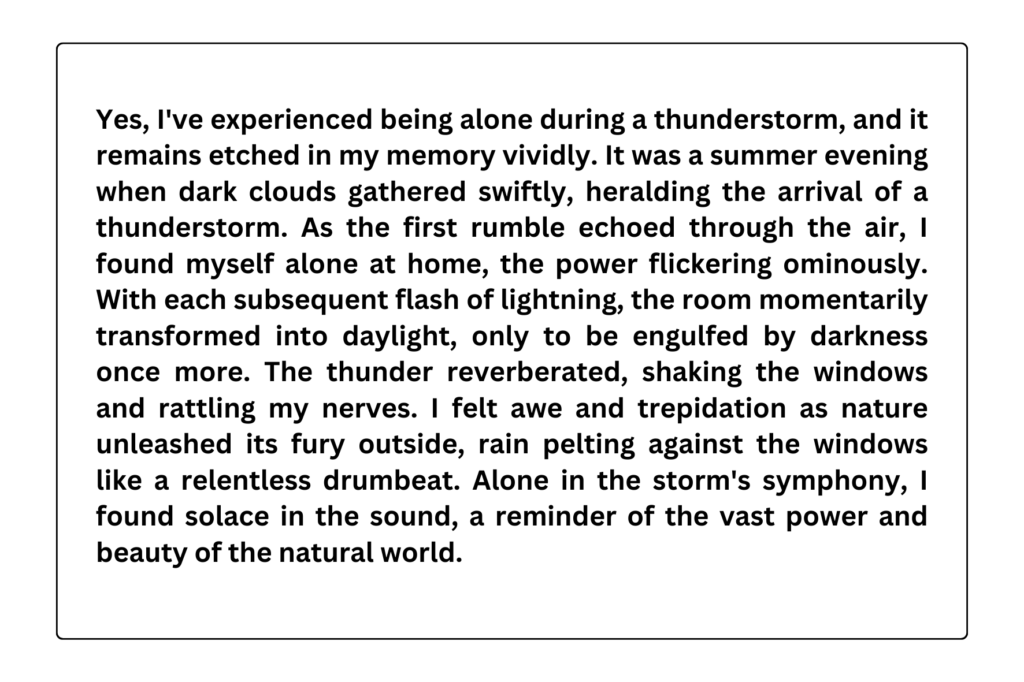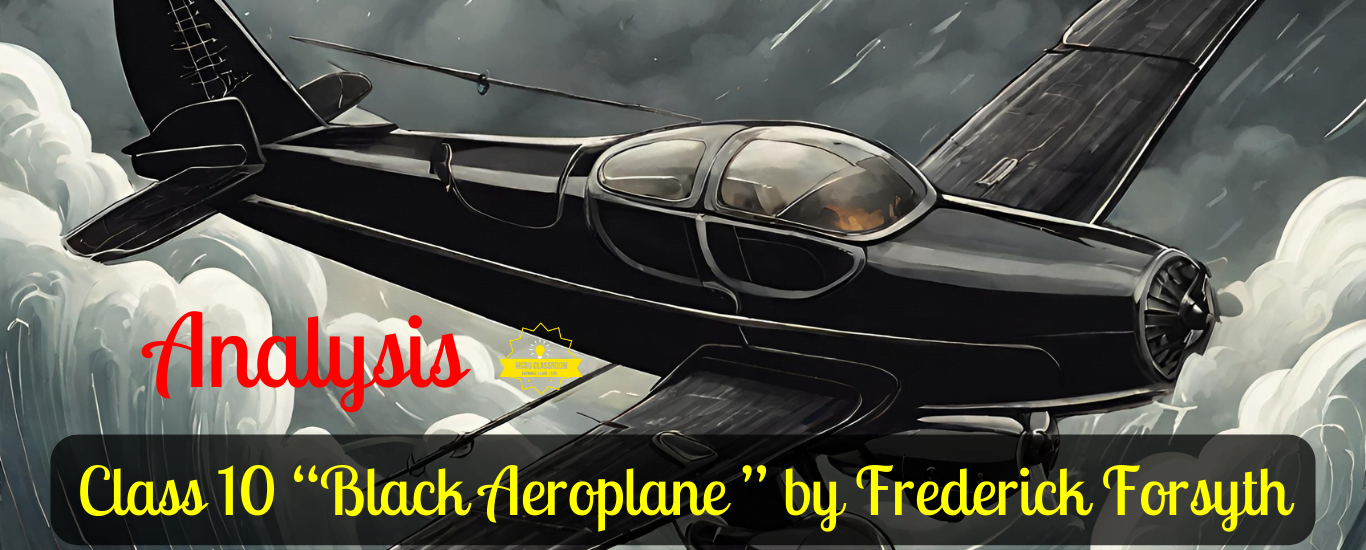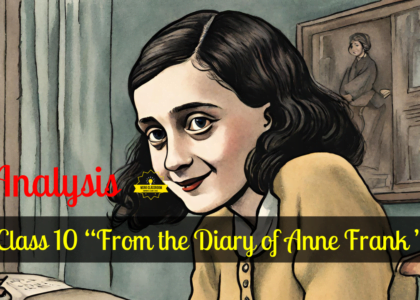Chapter 3, Story II-“Two Stories About Flying-Black Aeroplane” Summary, Theme, Important Passages, Question Answers and Textbook Exercises.
Chapter 3-Two Stories About Flying
Story 2: “Black Aeroplane” by Frederick Forsyth
Table of Contents
Next: “How To Tell Wild Animals” by Carolyn Wells
Vocabulary:
- Dakota- a type of transport aircraft that refers to the Douglas DC-3 or similar models.
- Control tower – a tall structure at an airport from which air traffic controllers manage the movement of aircraft on the ground and in the airspace around the airport.
- Runway – a levelled strip of smooth ground along which aircraft take off and land.
- Radar – a system that uses reflected radio waves to detect the presence, direction, distance, and speed of aircraft, ships, and other objects.
- Paris – the capital city of France.
- Sky – the region of the atmosphere and outer space seen from the Earth.
- Countryside – rural areas outside towns and cities, typically characterised by open land, farms, and natural scenery.
Summary “Black Aeroplane”:
In “The Black Aeroplane” by Frederick Forsyth, a pilot flying over France encounters a storm, losing navigation and communication instruments. He sees another plane in the storm, unlit but with a visible pilot gesturing to follow. Trusting the mysterious pilot, he follows and eventually lands safely at an airport.
However, no other planes were recorded on radar, leaving the pilot to wonder who helped him. The story leaves the identity of the black aeroplane’s pilot open-ended, suggesting a supernatural or unexplained intervention.
Theme “Black Aeroplane”:
The theme of “The Black Aeroplane” revolves around unseen assistance and mysterious intervention during moments of peril. The protagonist (pilot), faced with a dangerous storm and technical malfunctions, experiences an inexplicable encounter with a black aeroplane and its pilot, who guides him to safety.
The story highlights the theme of unexpected aid in times of crisis, suggesting the presence of unseen forces or guardian angels. It explores the concept of trust and reliance on external help, even when circumstances seem dire. The story delves into the unknown, leaving readers to ponder the mysteries of fate and the possibility of supernatural intervention in human affairs.
Important Lines/ Passages:
1. “I was flying my old Dakota aeroplane over France back to England.” This line establishes the setting and the protagonist’s actions. It indicates that the narrator is piloting a Dakota aeroplane from France to England.
2. “‘I should call Paris Control soon,’ I thought.” The narrator considers contacting Paris Control, which suggests adherence to standard aviation procedures and communication protocols while flying.
3. “Paris was about 150 kilometres behind me when I saw the clouds. Storm clouds.” The appearance of storm clouds marks a significant change in the weather conditions and foreshadows potential challenges or dangers for the narrator’s flight.
4. “Inside the clouds, everything was suddenly black. It was impossible to see anything outside the aeroplane.” The description of everything turning black inside the clouds emphasises the intensity and disorientation caused by flying through the storm. It conveys a sense of danger and the loss of visibility.
5. “The compass was turning round and round and round. It was dead.” The malfunction of the compass adds to the narrator’s predicament, highlighting the loss of navigational aids and increasing the difficulty of determining their position or direction. This further heightens the tension and sense of being lost in the storm.
6. “I had no radio, no compass, and I could not see where I was. I was lost in the storm.” This line highlights the dire situation the narrator finds themselves in. Without a functioning radio, compass, or visibility, they are completely disoriented and lost within the storm, heightening the tension and sense of vulnerability.
7. “Then, in the black clouds quite near me, I saw another aeroplane.” The sudden appearance of another aeroplane amidst the storm adds a mysterious and unexpected element to the narrative, offering a glimmer of hope or assistance in the protagonist’s dire situation.
8. “He lifted one hand and waved. ‘Follow me,’ he was saying. ‘Follow me.” The gesture of the pilot in the other aeroplane, waving and signalling for the narrator to follow, suggests a willingness to help or guide them through the storm, offering a lifeline amidst the chaos.
9. “He turned his aeroplane slowly to the north, in front of my Dakota, so that it would be easier for me to follow him.” By turning their aeroplane to the north and positioning themselves in front of the narrator’s aircraft, the mysterious pilot makes it easier for the narrator to follow and suggests a clear direction out of the storm, further solidifying the sense of guidance and assistance.
10. “After half an hour, the strange black aeroplane was still there in front of me in the clouds.” The black aeroplane’s continued presence despite the tumultuous conditions suggests a persistent and almost supernatural quality to its assistance, maintaining a steady presence and guiding the narrator through the storm.
11. “But then he started to go down and I followed through the storm.” The decision of the mysterious pilot to descend indicates a strategic manoeuvre to lead the narrator towards safety, further reinforcing their role as a guiding force amidst the chaos of the storm.
12. “Suddenly I came out of the clouds and saw two long straight lines of lights in front of me. It was a runway! An airport! I was safe!” As the protagonist emerges from the storm clouds, the sight of two long, straight lines of lights ahead signifies the presence of a runway and an airport, offering a beacon of safety and relief amidst the storm’s chaos.
13. “I turned to look for my friend in the black aeroplane, but the sky was empty. There was nothing there. The black aeroplane was gone.” Upon reaching safety, the protagonist searches for the mysterious black aeroplane that guided them through the storm but finds no trace of it. The sudden disappearance of the black aeroplane adds an element of mystery and intrigue to the story, leaving the protagonist puzzled about the true identity and intentions of their enigmatic guide.
14. “‘Another aeroplane? Up there in this storm? No other aeroplanes were flying tonight. Yours was the only one I could see on the radar.’” A person in the control tower dismisses the protagonist’s account of another airplane guiding them through the storm, asserting that no other aircraft were flying that night beside the protagonist’s. This statement contradicts the protagonist’s experience, deepening the mystery surrounding the black airplane and prompting questions about its existence and purpose in the narrative.
Question Answers “Black Aeroplan”:
Thinking About The Text:
Q1: “I’ll take the risk.” What is the risk? Why does the narrator take it?
A1: The narrator takes the risk of flying the old Dakota aeroplane straight into the storm despite knowing the dangers associated with it. The narrator decides to take this risk because they are determined to reach their destination and eager to reunite with their family, as indicated by their anticipation of a big English breakfast. Also, there is a sense of optimism and confidence in the narrator’s abilities to navigate the storm despite the adverse conditions.
Q2: Describe the narrator’s experience as he flew the aeroplane into the storm.
A1: The narrator’s experience flying the aeroplane into the storm is intense and disorienting. Inside the clouds, everything becomes black, making it impossible to see anything outside the aircraft. The compass malfunctions, turning round and round, rendering it useless. The other instruments also fail, and the radio communication with Paris Control ceases.
The aeroplane jumps and twists in the turbulent air, adding to the sense of danger and uncertainty. Despite these challenges, the narrator presses on, guided only by their determination to reach safety.
Q3: Why does the narrator say, “I landed and was not sorry to walk away from the old Dakota…”?
A3: The narrator says, “I landed and was not sorry to walk away from the old Dakota,” indicating a sense of relief and gratitude for having survived the ordeal. This statement suggests that the narrator is glad to have safely landed the aeroplane and is ready to leave it behind, symbolising the end of a harrowing experience and the beginning of a return to safety and normalcy.
Q4: What made the woman in the control centre look at the narrator strangely?
A4: The woman in the control centre looks at the narrator strangely when they inquire about the other pilot and aeroplane. The narrator’s account of being guided by another aircraft through the storm contradicts the radar data, which showed no other aeroplanes nearby.
The discrepancy between the narrator’s experience and the radar information causes the woman to be intrigued and sceptical about the validity of the narrator’s story.
Q5: Who do you think helped the narrator to reach safely? Discuss this among yourselves and give reasons for your answer.
A5: The identity of the mysterious pilot who guided the narrator through the storm is unclear in the story. One interpretation could be that the pilot is a supernatural or divine entity providing guidance and assistance in a time of need. Another possibility is that the pilot is a hallucination or a figment of the narrator’s imagination, brought on by the stress and disorientation of flying through the storm.
Alternatively, it could be speculated that the pilot is a skilled aviator who happened to be flying in the area and chose to help the narrator in their time of need. However, this explanation seems less likely given the extreme conditions of the storm. Ultimately, the story leaves the question of the pilot’s identity open to interpretation, adding to its mysterious and enigmatic nature.
Thinking About Language:
I. Study the sentences given below.
Now, try to guess the meanings of the word ‘black’ in the sentences given below. Check the meanings in the dictionary and find out whether you have guessed right.
1. Go and have a bath; your hands and face are absolutely black. “black” refers to the colour associated with dirt or grime, indicating that the hands and face are covered in mud or soot.
2. The taxi-driver gave Ratan a black look as he crossed the road when the traffic light was green. Here, “black” is used metaphorically to describe the expression on the taxi driver’s face, suggesting that it was unfriendly, hostile, or disapproving.
3. The bombardment of Hiroshima is one of the blackest crimes against humanity. In this sentence, “black” is used metaphorically to describe the severity or darkness of the crime, conveying a sense of extreme wrongdoing or moral darkness.
4. Very few people enjoy Harold Pinter’s black comedy. “Black” is used here to describe the type of comedy associated with Harold Pinter, indicating that it is dark, cynical, or bleak.
5. Sometimes shopkeepers store essential goods to create false scarcity and then sell these in black. “black” is used to describe the market where goods are sold illegally or without proper authorisation, often implying evasion of taxes or regulations.
6. Villagers had beaten the criminal black and blue. “Black and blue” is an idiom that describes severe bruising or physical injury caused by beating or violence.
II. Look at these sentences taken from the lesson you have just read:
Match the phrases given under Column A with their meanings given under Column B:
Answers:
| A | B |
| 1. Fly a flag 2. Fly into rage 3. Fly along 4. Fly high 5. Fly the coop | Display a flag on a long pole Become suddenly very angry Move quickly/suddenly Be successful Escape from a place |
III. We know that the word ‘fly’ (of birds/insects) means to move through air using wings. Tick the words which have the same or nearly the same meaning.
Answers:
- Swoop
- Flit
- Flutter
- Ascend
- Float
- Skim
- Dart
- Hover
- Glide
- Soar
- Sail
- Flap
Writing:
Have you ever been alone or away from home during a thunderstorm? Narrate your experience in a paragraph.
Sample Paragraph:

Extra Questions “Black Aeroplane”:
Short Answer Type Questions:
Q1: What was the protagonist’s initial feeling as he flew his Dakota over France back to England?
A1: The protagonist (pilot) felt happy and content being alone above the sleeping countryside, dreaming of his holiday and looking forward to being with his family.
Q2: Why did the pilot need to contact Paris Control during his flight?
A2: He needed to contact Paris Control to ensure his flight path and receive any necessary instructions or updates for his journey back to England.
Q3: What were the instructions given to the protagonist by Paris Control?
A3: Paris Control instructed the protagonist to turn twelve degrees west, altering his course towards England.
Q4: Why did the pilot hesitate to return to Paris when encountering storm clouds ahead?
A4: Despite encountering storm clouds ahead, the pilot hesitated to turn back to Paris because he was eager to reach home and anticipated a satisfying English breakfast.
Q5: Describe the protagonist’s experience inside the storm clouds.
A5: Inside the storm clouds, everything turned black, making it impossible to see outside the aeroplane. The aircraft experienced turbulence, and crucial instruments like the compass and radio ceased functioning.
Q6: How did the protagonist react when he spotted another airplane within the storm clouds?
A6: The protagonist is relieved and grateful to see another aeroplane. He interprets the pilot’s gesture as an invitation to follow him and feels reassured by the presence of another person amidst the storm.
Q7: What emotions did the protagonist experience following the strange black aeroplane?
A7: The protagonist felt relief and fear as he followed the strange black aeroplane. Relief stemmed from having guidance in the storm, while fear lingered due to uncertainty about the situation.
Q8: What happened when the pilot emerged from the clouds and saw a runway ahead?
A8: Upon emerging from the clouds and spotting a runway, the pilot felt a sense of safety and relief. He realised he had reached an airport and was able to land safely.
Q9: How did the protagonist react upon realising that there was no trace of the black aeroplane?
A9: The protagonist felt puzzled and bewildered upon realising that the black aeroplane had vanished. He sought answers from the control centre but received disbelief from the woman he spoke to.
Q10: What lingering question does the protagonist have at the end of the story?
A10: The protagonist wonders about the identity of the mysterious pilot in the black aeroplane and how they guided him safely through the storm without any visible means of communication.
Q11: How did the pilot initially react to the storm clouds looming ahead?
A11: Initially, the pilot considered turning back to Paris but ultimately decided to take the risk and fly straight into the storm, driven by his desire to reach home.
Q12: Describe the pilot’s mindset as he follows the strange black aeroplane through the storm.
A12: The pilot felt a mixture of apprehension and gratitude as he followed the mysterious aircraft. He was grateful for the guidance it provided but also felt anxious about the unknown intentions of the pilot.
Q13: What role did the black aeroplane play in guiding the protagonist to safety?
A13: The black aeroplane served as a guiding presence, leading the protagonist through the storm and eventually to the safety of an airport runway despite the protagonist’s lack of functioning instruments.
Q14: How did the pilot attempt to express his gratitude to the mysterious pilot?
A14: Upon landing safely, the pilot sought to thank the pilot of the black aeroplane by inquiring about their identity and expressing gratitude for their assistance during the storm.
Q15: What was the reaction of the control centre staff when the pilot mentioned the black aeroplane?
A15: The control centre staff reacted with disbelief and amusement when the pilot mentioned the black aeroplane, dismissing the idea of another aircraft flying in the storm and suggesting the protagonist might have imagined it.
Q16: How does the story highlight themes of mystery and the unknown?
A16: The story presents the mysterious appearance of the black aeroplane and its enigmatic pilot, leaving the protagonist and readers alike questioning their identity and the supernatural assistance provided during the storm.
Q17: Discuss the significance of the protagonist’s decision to trust the black aeroplane.
A17: By choosing to trust and follow the black aeroplane through the storm despite its unconventional appearance, the protagonist is willing to embrace the unknown and rely on intuition in times of crisis.
Q18: How does the story explore themes of resilience and determination?
A18: The protagonist’s decision to press on through the storm despite the risks involved showcases their resilience and determination to overcome obstacles in pursuit of their goal, ultimately leading to a safe landing.
Q19: What might be the symbolic significance of the black aeroplane in the story?
A19: The black aeroplane could symbolise a guardian angel or a mysterious force guiding the protagonist through adversity, emphasising themes of fate, providence, and the inexplicable in the face of danger.
Q20: How does the story’s ending leave the protagonist and readers contemplating the unexplained events?
A20: The story’s unresolved ending leaves both the protagonist and readers pondering the inexplicable nature of the black aeroplane’s appearance and disappearance, inviting speculation and interpretation about its significance in the protagonist’s journey.
Long Answer Type Questions:
Q1: How did the protagonist communicate with Paris Control during the flight?
A1: The protagonist communicated with Paris Control during the flight using the radio in his Dakota aeroplane. He switched on the radio and established contact with Paris Control by transmitting his aircraft’s call sign, “Dakota DS 088,” and informing them of his flight path from France to England. Paris Control responded promptly, providing instructions and guidance to the protagonist regarding adjustments to his course.
This communication allowed the protagonist to stay informed about any air traffic updates, ensuring a safer and more organised journey despite the challenges encountered, such as the onset of storm clouds later in the flight.
Q2: Describe the protagonist’s encounter with storm clouds during the flight.
A2: As the protagonist flew his Dakota aeroplane over France back to England, he spotted ominous storm clouds looming ahead in his flight path. These clouds resembled black mountains in the sky, signalling the onset of turbulent weather conditions.
Despite the initially clear sky, the protagonist was surrounded by dark, menacing clouds, which obscured his visibility and created an intimidating atmosphere. The storm clouds posed a significant obstacle to his journey, presenting a formidable challenge for navigation and safe flight challenge.
However, instead of returning to Paris, the protagonist made the daring decision to fly directly into the heart of the storm, driven by his determination to reach his destination.
Q3: What happened to the protagonist’s instruments inside the storm?
A3: Inside the storm clouds, the protagonist’s instruments experience a sudden and catastrophic failure. Initially functioning normally, crucial navigational tools like the compass and radio abruptly ceased to operate, leaving the protagonist disoriented and vulnerable.
The compass spun aimlessly, rendering it useless for determining direction, while attempts to communicate with Paris Control via the radio proved futile as it fell silent.
Other instruments onboard the aircraft also failed, compounding the protagonist’s predicament. This instrument failure exacerbated the already tricky situation inside the storm, plunging the protagonist into a state of uncertainty and increasing the difficulty of navigating through turbulent weather conditions.
Q4: How did the mysterious black aeroplane help the protagonist during the flight?
A4: The mysterious black aeroplane appeared unexpectedly amidst the storm clouds, flying alongside the protagonist’s Dakota aircraft. Despite lacking conventional navigation aids like lights on its wings, the black aeroplane provided crucial assistance to the protagonist. Its pilot, though unseen, signalled to the protagonist to follow, guiding him through the turbulent skies.
By maintaining a position ahead of the Dakota, the black aeroplane effectively led the protagonist through the storm, acting as a beacon of guidance in the darkness.
The unexpected assistance proved instrumental in helping the protagonist navigate safely through the storm clouds, ultimately leading him to the safety of an airport runway and facilitating a successful landing despite the adverse conditions.
Q5: What was the protagonist’s reaction upon reaching the safety of the airport runway?
A5: Upon reaching the safety of the airport runway, the protagonist experiences a profound sense of relief and gratitude. Emerging from the treacherous storm clouds, the sight of the illuminated runway and airport lights filled the protagonist with reassurance and comfort.
As he guided his Dakota aeroplane towards the landing strip, the weight of the harrowing ordeal began to lift, replaced by a surge of relief at having survived the perilous journey.
Despite the mysterious disappearance of the black aeroplane that had guided him through the storm, the protagonist felt deeply grateful for the unknown pilot’s assistance. Stepping onto solid ground, he was overwhelmed with emotions, thankful for the safe conclusion of his tumultuous flight.
*****





